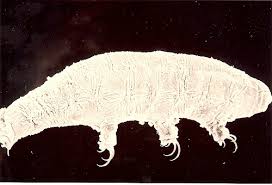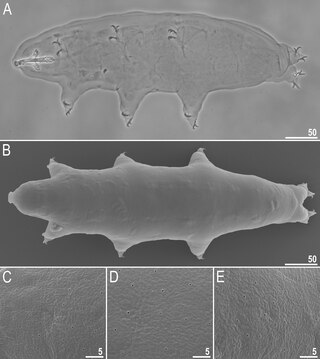
Hypsibius is a genus of tardigrades in the class Eutardigrada.
Diphascon is a genus of water bear or moss piglet, a tardigrade in the class Eutardigrada.

Doryphoribius is a genus of water bear or moss piglet, a tardigrade in the class Eutardigrada.
Pseudobiotus is a genus of water bear or moss piglet, a tardigrade in the class Eutardigrada.
Parascon is a genus of water bear or moss piglet, a tardigrade in the class Eutardigrada.

Itaquascon is a genus of tardigrade in the class Eutardigrada.

Isohypsibius is a genus of water bear or moss piglet, a tardigrade in the class Eutardigrada. The length of an isohypsibius tardigrade ranges from 0.1 millimeters to 1.5 millimeters. In addition to eating algae and plant cells, tardigrades also consume insect larvae and even other tardigrades. They live in a lot of places, like damp wooded areas with moss, lichens, leaf litter, and dirt. These animals can also be found in natural lakes and ponds.
Eremobiotus is a genus of tardigrade in the class Eutardigrada.

Milnesium is a genus of tardigrades. It is rather common, being found in a wide variety of habitats across the world. It has a fossil record extending back to the Cretaceous, the oldest species found so far is known from Turonian stage deposits on the east coast of the United States. Milnesiums are one of the most desiccation and radiation-resistant invertebrates on Earth because of their unique ability to transform into a "tun" state and utilize intrinsically disordered proteins when experiencing extreme environments.

Echiniscus is a genus of tardigrades in the family Echiniscidae. The genus was named and described by Karl August Sigismund Schultze in 1840.
Pseudechiniscus is a genus of tardigrades in the family Echiniscidae. The genus was named and described by Gustav Thulin in 1911.

Bryodelphax is a genus of tardigrades in the family Echiniscidae. The genus was first described by Gustav Thulin in 1928.
Bryodelphax meronensis is a species of tardigrade in the genus Bryodelphax which belongs to the family Echiniscidae. The species is endemic to Israel and is found in the area of Mount Meron. The species was first described by Giovanni Pilato, Oscar Lisi and Maria Grazia Binda in 2011. The specific name comes from the location where it was discovered.
Macrobiotidae is a family of tardigrade. As of 2023, it consists of the following genera:

Macrobiotus is a genus of tardigrade consisting of about 100 species.
Hypsibius septulatus is a species of tardigrade in the class Eutardigrada. The species is only known to be found in Peru. Hypsibius septulatus has unsculptured cuticles with around 22 dorsal undulations. It has two macroplacoids and a septulum on the first three pair of legs.
Richtersiidae is a family of tardigrades belonging to the order Parachela.
Calcarobiotus is a genus of tardigrades belonging to the family Macrobiotidae.
Mesobiotus is a genus of tardigrades belonging to the family Macrobiotidae.







